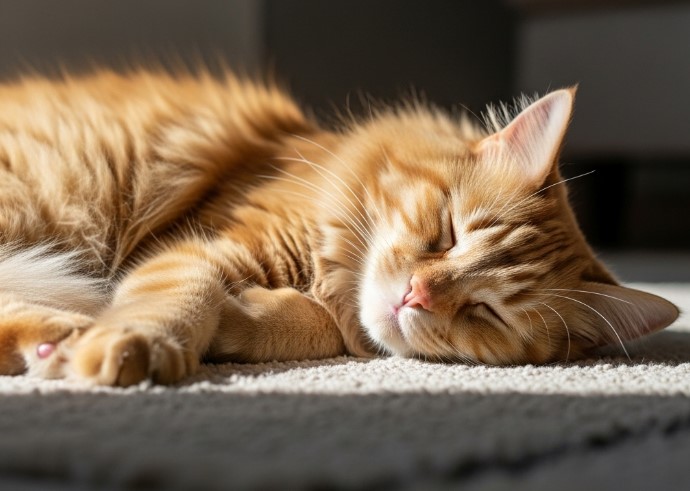Understanding the Sleep Habits of Your Feline Friend
If you’ve ever lived with a cat, you’ve probably noticed that they seem to spend most of their time curled up in a cozy spot, fast asleep. Whether they’re napping in a sunbeam, sprawled across your keyboard, or bundled up in a laundry basket, cats are expert sleepers.
But just how many hours do cats sleep a day? The short answer: a lot more than humans — often between 12 to 16 hours per day, and sometimes even more. In this article, we’ll explore the science behind why cats sleep so much, how their age and lifestyle affect their sleep patterns, and what it might mean if your cat sleeps too little (or too much).
🕐 The Average Cat Sleeps 12–16 Hours a Day
Most cats sleep an average of 13 to 14 hours a day, though this can vary depending on age, health, and activity level. Some especially lazy or older cats may sleep up to 20 hours in a 24-hour period.
Cats are among the sleepiest animals on the planet. In fact, they’re what scientists call “crepuscular” — meaning they’re most active during the dawn and dusk hours. That leaves plenty of time in between for long naps and deep sleep.
🐱 Sleep by Age: How It Changes Over Time
🐾 Kittens (0–6 months)
Kittens can sleep up to 20 hours a day. Their bodies are growing rapidly, and sleep helps support brain development, immune function, and energy restoration. Play hard, sleep harder!
🐾 Adult Cats (1–7 years)
Healthy adult cats generally sleep around 13–16 hours daily. They may become more active if they’re stimulated (playtime, outdoor access, etc.), but rest is still a huge part of their routine.
🐾 Senior Cats (7+ years)
Older cats often return to kitten-like sleep habits. They might sleep up to 18–20 hours per day as their metabolism slows down and energy levels drop.
🌙 Why Do Cats Sleep So Much?
1. Instinct and Evolution
Cats evolved as predators — hunters that needed short bursts of intense energy followed by rest and recovery. This pattern is still hardwired into their DNA. Even if your housecat never has to hunt, their body still follows this ancient rhythm.
2. Energy Conservation
Cats burn a lot of energy in short spurts when they play or chase prey. Their long naps help them conserve energy for these moments of intense activity.
3. Weather and Seasons
Just like humans, cats may sleep more on cold, rainy, or gloomy days. They’re affected by temperature and light levels, often becoming more lethargic in winter.
4. Boredom or Lack of Stimulation
Indoor cats, especially those without enrichment, may sleep more simply because they have nothing else to do. Providing toys, climbing structures, and interactive play can help balance this.
💤 Do Cats Sleep Like Humans?
Not exactly. While humans typically go through long, uninterrupted periods of sleep, cats tend to alternate between light naps and deep sleep cycles. About 70% of their sleep is light — meaning they’re resting but still alert enough to wake up instantly at the sound of a noise.
During deep sleep, you may see them twitch, paddle their paws, or even vocalize — a sign they’re likely dreaming.
🔄 Cat Sleep Patterns: A Daily Timeline
Here’s a rough breakdown of a typical cat’s day:
| Time of Day | Activity |
|---|---|
| Early Morning (Dawn) | Active, hunting/play instinct kicks in |
| Late Morning to Afternoon | Long naps, light dozing |
| Early Evening (Dusk) | Another active phase |
| Night | Alternates between sleep and light activity |
This schedule mirrors that of wild cats who are most active at dawn and dusk — when prey is easiest to catch.
🧠 Can Cats Sleep Too Much?
Yes — although sleeping a lot is normal, excessive or sudden changes in sleep habits can be a sign of health issues such as:
- Depression or boredom
- Obesity or poor diet
- Arthritis or pain
- Diabetes
- Hypothyroidism
- Kidney or liver issues
If your cat is suddenly sleeping more (or less) than usual and seems lethargic, disinterested in food, or irritable, consult a veterinarian.
🐾 How to Support Healthy Cat Sleep
- Create a quiet, cozy sleep environment. Cats love soft, elevated places or secluded corners.
- Keep a routine. Cats thrive on daily rhythm — feeding, playtime, and quiet hours.
- Provide enrichment. Toys, scratching posts, window perches, and interactive games can help reduce boredom-based sleep.
- Monitor behavior. Learn your cat’s baseline habits so you can notice changes early.
✅ Summary: Key Takeaways
| Cat Type | Average Sleep Per Day |
|---|---|
| Kittens | 16–20 hours |
| Adult Cats | 12–16 hours |
| Senior Cats | 16–20 hours |
- Cats are natural nappers — sleeping more than half the day is normal.
- They follow crepuscular rhythms: active at dawn/dusk, resting the rest.
- Changes in sleep habits may signal a health concern and should be watched.
🐱 Final Thoughts
Cats sleep a lot — and that’s perfectly normal. Whether they’re dreaming of chasing birds or just enjoying the warmth of your bedspread, their rest is essential to their well-being. Understanding their unique sleep patterns can help you be a better cat parent and ensure your furry companion stays happy, healthy, and well-rested.
Next time you catch your cat napping for the sixth time today, just remember — they’re not lazy. They’re just being a cat.

